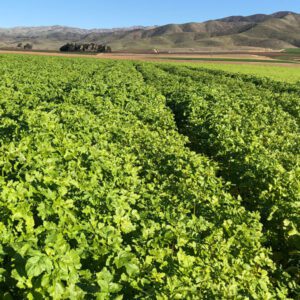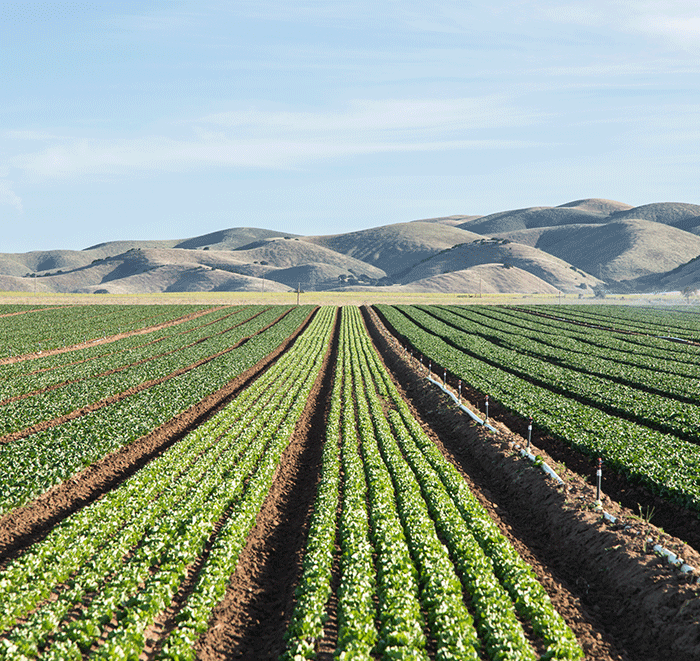Many growers are hesitant to plant cover crops or reduce or eliminate tillage, given various factors such as logistics, cost and timing. But crops still need a sufficient supply of carbon materials to build and maintain soil structures, to increase cation exchange capacity (CEC) and moisture holding capacity and to feed the soil microbials that help cycle nutrients and build resilient, disease-suppressive soils.
Enter humic acid.
“Humic acid is a high carbon material that is extremely important for nutrient availability in the soil because it holds onto nutrients,” says Gina Colfer, certified crop adviser, Wilbur-Ellis Agribusiness.
“With humic acid, you’re not only adding carbon to the soil, but also helping to increase the cation exchange capacity of your soil, which builds sites for nutrients to adhere to,” states Colfer.
Humic acid is a group of molecules that help plant roots receive water and nutrients. By increasing humic acid levels, growers can achieve yield increases and the following additional benefits:
-
- Enhanced plant vigor
- Increased plant growth
- Resilience to plant stress
“When soils have a higher humic acid content, plants can put more energy into growing and increasing yield and less energy on searching for minerals and water,” said Colfer. “Humic acids add value to crops for growers and improve their ROI.”
Humic acid v. soil organic matter

When considering humic acid, it’s important to understand how the substance differs from and is related to soil organic matter (SOM). Soil organic matter is formed by the biological, chemical and physical decay of organic materials on and below the surface of the soil. Comprised of plant and animal residues at various stages of decomposition, SOM helps hold water and nutrients while providing food for soil microbes that recycle nutrients.
Humic acid includes the biologically active or functional fraction of soil carbon. Humic substances can increase water holding capacity of soil, improve nutrient availability and uptake and increase the soil’s cation exchange capacity. Leonardite ore is rich in humic acid. When producing a high-quality humic acid product, the ore must be properly reacted with a strong base to ionize and solubilize the humic acid fractions contained in the ore. Combined with organic fertilizers, humic acid efficiently improves soil fertility and crop productivity.
“Strategically placed humic acids can produce measurable results,” said Colfer.
Fulvic acid is another component of humic substances that has its own set of benefits for plant growth.
Differences between Active organic matter and humic acid
| Soil Organic Matter (SOM) | Humic Acid |
|---|---|
| It is relatively less complex. | It is highly complex |
| New and partially decomposed organic matter. | Naturally formed from long-term decomposition of ancient plant remains. |
| It is unstable. | It is very stable. |
| Organic matter further decomposes. | Humic acid resists further decomposition. |
| Original tissues can be recognized. | Original tissues cannot be recognized. |
| It is less dark in color. | It is darker in color. |
| Not colloidal in nature. | Colloidal in nature. |
Ways to apply humic acid
Growers serious about improving or rehabilitating their soil, increasing its CEC and improving soil structure, porosity and water availability often find a solution in humic acid. Humic acid offers versatile application methods, with liquid, granular and powdered forms available to best fit each grower’s needs.
- Soil conditioner: Humic acid is best used as a soil conditioner. Not all soils are suitable for farming or planting, but humic acid promotes better plant and soil health by improving nutrient uptake and enhancing soil structure, which enables the soil to hold more water.
- Seed coat: Humic acid is also commonly used as a seed treatment to promote faster germination and to protect seedlings.
- Foliar spray: Spraying humic acid is one of the fastest application methods that allows growers the opportunity to cover a wider area in a shorter timeframe. Humic acid can be sprayed on plant leaves or directly on the soil, and both approaches can boost plant health and ensure a strong yield.
- Drip irrigation: Growers often mix humic acid with irrigation water and disperse the solution through a drip irrigation system to improve soil structure.
- Granular form: In powder form, humic acid can be applied in the furrow or diluted in water and sprayed on the soil.
Where to start

After making the decision to apply humic acid, growers can assess their soil type and structure with the help of a local agronomist to determine the right application rate.
“You might see a benefit on a sandier soil from higher rates of humic acids, whereas a heavier clay-type soil may benefit from lower rates,” Colfer explained. “If you’re on a sandy soil that has 1% organic matter, then there isn’t much available carbon as a food source for soil microbes. In that case, you’d want to increase the available carbon to feed the microbes.”
Some humic acid products are approved for organic production and available at local retail distribution centers. One example of a wettable, granular formulation available to organic growers is PURIC® WSG. The formulation acts quickly to enhance soil structure and health and to enhance nutrient availability and uptake. It also delivers long-lasting efficacy in the field.
Wilbur-Ellis is happy to share more about the benefits of humic acid to interested growers. Contact a local representative for more information.

